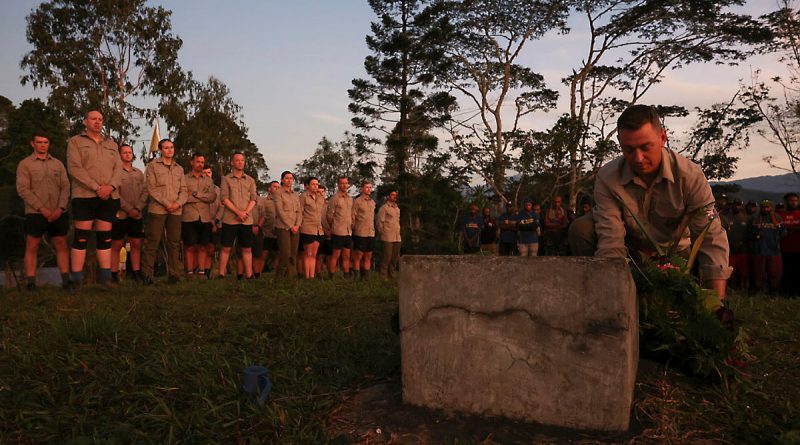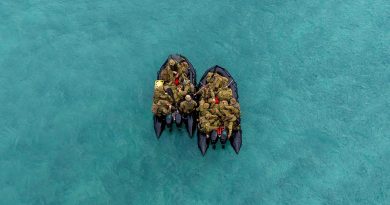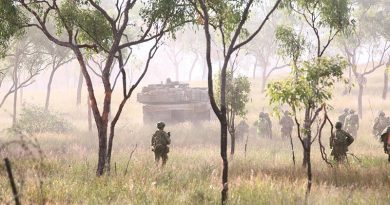Remembering Kokoda

Several events have been organised to mark the 80th year since the Kokoda Track Campaign in Papua New Guinea during World War Two.
CAPTION: Lieutenant Colonel Leigh Partridge, commanding officer of the 16th Battalion, Royal Western Australia Regiment, lays a wreath during a dawn service commemorating 80 years since the start of the Battle of Brigade Hill, along the Kokoda Track, in Papua New Guinea. Story and photo by Warrant Officer Class Two Max Bree.
On one of them, after starting from opposite ends of the track, soldiers from 16th Battalion, Royal Western Australia Regiment (16RWAR) and 39th Operational Support Battalion (39OSB) came together for a dawn service at a site on Brigade Hill on September 6 to commemorate the 62 Australian soldiers killed in fighting there.
The sounds of insects and the occasional bird that could be heard during the ceremony were a far cry from those of gunfire, grenades and shouted orders that rang out across the battle site 80 years ago.
Over two days’ fighting in September 1942, Japanese forces engaged the forward Australian elements at Mission Ridge, before flanking and sending an attack force up Brigade Hill.
Despite fierce resistance, the Japanese exploited gaps in the line and forced the Aussies off the high ground and into the jungle.
16RWAR is a successor unit to 2/16 Battalion, which fought in the battle, while 39OSB carries lineage of militia unit 39 Battalion, one of the first committed to fight in the Kokoda campaign.
Commanding Officer 16RWAR Lieutenant Colonel Leigh Partridge said the mud, mountains and vegetation would have made the area difficult to fight in.
“During this battle there were bayonet attacks, brutal close combat. There was encirclement, there were counter-attacks and then Australian elements broke contact and moved to the rear to establish subsequent defensive positions,” he said.
Just before the battle, 39 Battalion – who’d been fighting without rest for weeks – were relieved by the 2/27 Battalion on nearby Mission Ridge.
They moved passed 2/14 and 2/16 Battalions on their way back.

CAPTION: Soldiers from 39OSB and attachments cross a stream on the Kokoda Trail in Papua New Guinea. Photo by Corporal Brandon Grey.
“We are re-enacting what was a rear passage of lines with the 39th withdrawing from the north and the 2/16 Bn reinforcing from the south,” Lieutenant Colonel Partridge said.
The Japanese flanking attack up Brigade Hill cut off the three infantry battalions from their HQ.
Counter-attacks from the 2/14 and 2/16 overran several Japanese positions but they were forced back by enemy reinforcements.
HQ troops later withdrew down the track, while the infantry battalions were forced down a steep jungle-covered mountain.
The 2/14 and 2/16 made it to HQ shortly after, but the 2/27 was stuck in the jungle for about two weeks, trying to reach retreating friendly forces.
Following the service, commanding officer 39OSB Lieutenant Colonel David Ready paid tribute to the link between his unit and the Papuan people.
“The Papuan Infantry Battalion and the 39th were the first two units committed to battle. There’s 80 years of shared fighting history,” he said.
“A lot of people remember the Fuzzy Wuzzy Angels, not the fact that the Papuans fought as well.
“Without them, there’s no way you could fight effectively in this environment.”

CAPTION: Contingents from 16RWAR and 39OSB stand at attention during a dawn service commemorating 80 years since the start of the Battle of Brigade Hill, along the Kokoda Track. Photo by Warrant Officer Class Two Max Bree.
.
.

.
.






For the first decades of my life, I never knew the PNG route as anything but the Kokoda Trail. Then there emerged talk of the Kokoda Track.
In the entrance to the Roman Catholic cathedral off Victoria Square in Adelaide, there hang several regimental colours, including those of the 43 Bn which, in the 1970s, became a Reserve unit known as The Bushman’s Rifles since it did its training in major blocks to suit the farmers etc.
Among the battle honours are clearly shown “Kokoda Trail.”
Interesting that Wiki heads the relevant article Kokoda Track with the opening paragraph stating “also known as Kokoda Trail..